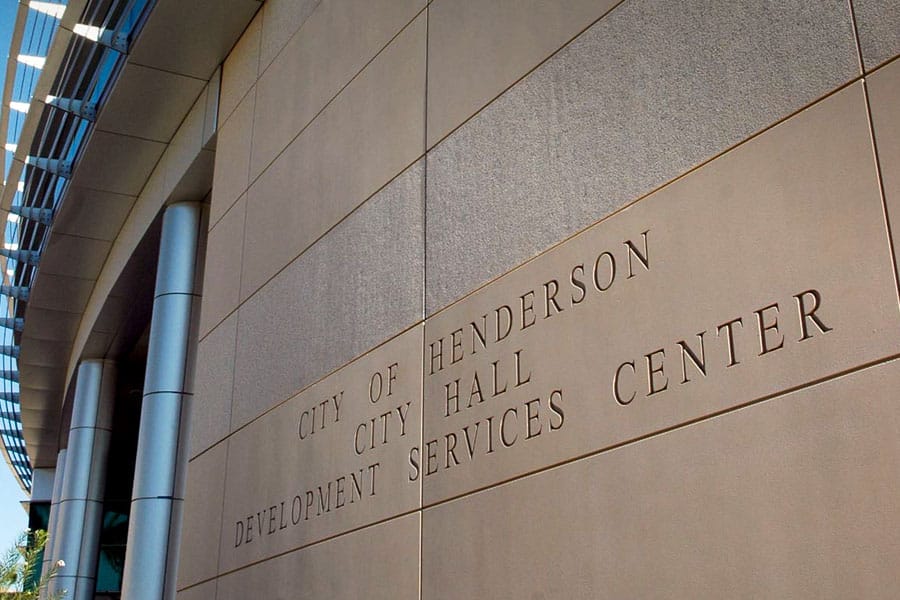Bluebeam gives teams the flexibility to work together anywhere in the world throughout the design, build and handover processes. The UK’s private sector has been using these tools for some time. But what are the benefits of using Bluebeam for public sector building projects? How can the system help the functionality and practicalities of local government?
To get some insight, Built, the Bluebeam Blog, turned to the city of Henderson’s Development Services Center (DSC) in southern Nevada just outside of Las Vegas, which has used Bluebeam Revu comprehensively since 2020.

With a population of nearly 350,000, Henderson occupies the southern rim of the Las Vegas Valley. It has 69 city parks, several municipal golf courses, numerous public schools, libraries, recreation centers and cultural facilities.
The DSC comprises nine different reviewing departments: building, fire safety, community development, zoning, water utilities, traffic review, flood review, right of way and parks.
Built spoke to Christopher “Topher” Barnes, the DSC’s manager, to discover how his team got to work with Bluebeam Revu and what benefits it has brought to his operation.
Built Blog: What does DSC do?
Barnes: The DSC is a one-stop shop to deal with anything relating to someone wanting to build something within the city of Henderson, whether that’s a residential project or a large commercial project. It also covers things like patios, pools and walls.
If you need to construct it, we’re the folks to come to. We do the permit intake, we look at your plans, we review them for life safety and compliance with zoning regulations, and much more besides.
Once your plans get the OK, we’ll be inspecting your project while it’s being constructed, and again after it’s been completed, to make sure that the approved plans match what’s been delivered.
Built Blog: What was the initial issue you were hoping to resolve by using Bluebeam Revu?
Barnes: We were looking to move toward reviewing plans electronically. We were already doing things very efficiently in paper, but there was a lot of paper to deal with. We require up to 10 different copies, with each plan set sometimes being more than 100 pages long. We started looking at the possibility of using electronic review packages around 2014–2015. We looked at a couple of options, but when we moved over to a new permitting system, the choice of Bluebeam was clear.
Built Blog: Why did you choose Bluebeam?
Barnes: There were a couple of strong contenders, not least because of limitations we were experiencing with our then-existing permit software. But once we moved into a new software system, we looked at the available tools and saw how Bluebeam was so widely adopted by a lot of other people who utilize markup software and realized it was quickly gaining acceptance across the board. And then, the software vendor said they were designing their system with Bluebeam in mind.
The cost of implementing Bluebeam, from professional services to ease of training and adoption, was also considered. Everybody we introduced it to found it a far less severe learning curve in terms of training and usage. In our view, Bluebeam offers the best fit to create a collaborative environment for all internal reviewers. We review everything in tandem. Our building, fire, flood, traffic, parks, right of way, water, utilities and our planning and zoning all review a plan at the same time.
Built Blog: How long did it take you to come up with what you wanted to do with Bluebeam? And then, how long did it take you to implement?
Barnes: We had already gone through a lot of the growing pains, right around 2004–2005, of solidifying everybody under one vision with our development services center. But getting software to mimic that is not as easy as it sounds. We knew early on that we wanted to do an electronic plan review, but there was some pushback. A lot of people love paper. We were probably a year into a pilot, and we had already developed some simple workflows that we wanted to utilize. We were using certain permit types to do that, to highlight the issues that we would run into in moving from paper to electronic. A lot of that surrounded communication rather than Bluebeam. For example, once we did something, how would we let somebody know we did it? And how did the customer know where to find it?
When the COVID-19 pandemic hit, we had already done some legwork. So as soon as people came to us at the DSC and said they needed a way to review plans, but not physically, we sorted it out in four days. We already had a pilot system up, and that’s kudos to my team. Customers were immediately open to it, as were reviewers. We knew the communication plan was going to be key, as well as training and getting everybody acclimated to what was ultimately a new process. I said to my team, “Necessity may be the mother of invention, but crisis is the discourager of hesitancy.” And because we had to, we did. If there was anything positive coming out of the pandemic, it was the fact that the usual barriers to change came down easily.

Built Blog: Was training more difficult because of the pandemic?
Barnes: It was challenging, but the team got through it. I never left the office because I was there to try to make sure everybody could stay connected. As I say, we’d had a small pilot program using Bluebeam, and before we moved to working from home, we did offer some preliminary training that a lot of the reviewers got into because they wanted to know how to use the software, so we brought in a third-party consultant to do the training. And that third-party consultant also developed standardized toolboxes and stamps for everybody. So we say we got it going in four days, which sounds awesome, but there was some legwork done beforehand in preparation for us eventually moving there.
Built Blog: Once Bluebeam was implemented, how did your team work together to decide the right sort of workflow?
Barnes: We already had a good workflow. But we have created an electronic plan review committee that meets every two weeks to discuss how electronic plan review has changed our lives. With Bluebeam, we don’t have to check the whereabouts of plans so much because we know where they’re located. As long as you have the permit number or the tracking number, you know exactly where it’s at. It’s exactly how you left it. It saves a lot of time.
Built Blog: How has using Bluebeam enhanced collaboration across stakeholders, either internal or external?
Barnes: Bluebeam has provided a really great collaboration tool, the kind that wasn’t available when we worked with paper plans. Customers say they like it. Bluebeam made it super simple for third-party plan review. So instead of sending physical files, since you have the collaboration over in Studio Sessions, you just send them the Session number. And as long as they’re invited to it, they can review it. It’s just like having them in the office. We didn’t have that before. Before, with paper, the customers would give us the plans, we would check them over, then wrap them up and overnight them to California or wherever they were being sent. And then they would eventually get sent back to us. That created a huge delay for our customers that we couldn’t avoid. And Bluebeam has made that a non-issue. Think of cost savings and the positive environmental impact in terms of paper and reduced fuel.
Built Blog: Given those factors, has acceptance of Bluebeam been straightforward?
Barnes: We had some plan reviewers who I thought would be slowest to adopt because in the early pilot season, they weren’t that keen. They really like physical plans, being able to flip through them and to see everything. Some of them had huge plans and studies, and they communicated that e-review wasn’t conducive to a good plan review, and so they couldn’t do it.But once we gave them the proper screen displays in their offices, they have become quickly accustomed to it. I wouldn’t be able to get those same people to even touch paper now.
Built Blog: What results have you seen since implementing Bluebeam? How do you look back now on the implementation journey?
Barnes: I think the journey went really fast. There were a lot of lessons learned that we didn’t have time to learn, in the sense of how things needed to be communicated out and how we could make the process better. We built a lot of steps into the workflows to make sure that we didn’t miss anything, so that nothing fell through the cracks.
In terms of results, in the past two years, even during the pandemic, we did record-level numbers of permits and plan reviews. And I can’t help but think that e-review, with the simplicity of it, had something to do with that, just in terms of how customers get to us. A customer never has to drive over to us to drop anything off. They apply through our system electronically. They can pay their fees electronically. They submit their plans, we process them, we route them electronically, they get reviewed electronically. They get stamped, they get sent out, and the inspectors are able to view the plans electronically on their field devices. There’s nothing simpler.
BLUEBEAM REVU SAVINGS OUTCOMES FOR THE CITY OF HENDERSON’S DSC
For the six months to the end of August 2020, the implementation of a model to submit plans electronically to the Henderson Development Services Center resulted in significant savings for the city.
Gasoline savings used to transport physical documents resulted in an estimated 9,130 gallons saved – 1,522 gallons a month – with a total financial savings of $20,998 (at 2020 prices), around $3,500/month.
Some 12.2 tons of paper were saved from not printing out physical plans throughout the six months – effectively two tons a month – and an equivalent 293 trees saved from being converted into paper, or 49 trees every month.
Extrapolating these figures to savings through to the end of November 2022, the city of Henderson will have saved an estimated 56,606 gallons of gasoline or $130,187 on the cost of fuel (based on 2020 prices at $2.29 per gallon). And 54 tons of paper have been saved, avoiding 1,323 trees being cut down. This is a substantial savings for a municipality moving from paper to digital while also improving its stakeholder processes, positively impacting the local community and helping the surrounding county become a great place to live. Learn more about how our software can drive efficiency for public sector construction.












